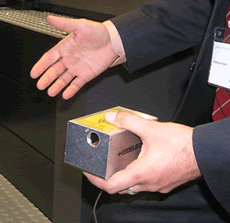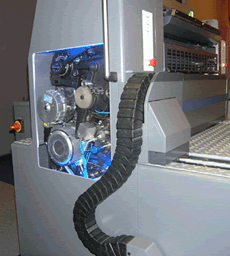Heidelberg is obviously a key drupa anchor exhibit, occupying two buildings right at the entrance to the fairgrounds (Halls 1 and 2). Heidelberg also made use of the International Lounge just across the street from the fairgrounds to entertain customers and other visitors. I had the pleasure of consuming two of the more than 12,000 gourmet meals prepared for Heidelberg guests by the company's corporate chef during drupa, including a dinner as part of the press briefing held the evening of Wednesday, May 5th, just prior to the official drupa opening, as well as a lunch meeting with Hans-Dieter Siegfried, Heidelberg's head of public relations, and Andreas Forer, Head of Product Management for Imaging Systems, during which I learned more about Heidelberg's imaging strategy. Siegfried and Forer are pictured above at the Heidelberg information stand.
Imaging Designated as a Heidelberg Core Competency
 As the WhatTheyThink team has already reported, Heidelberg has developed a new laser imaging module, a 64-channel, 830 nm laser. Its first commercial appearance is in the new Suprasetter series, a new generation of thermal external drum imagesetters in 4- and 8-page formats currently in beta testing and due to be available by the end of the year. All parts of this product, including the new imaging module, have been developed by Heidelberg and it supports all standard Heidelberg plate formats for sheetfed and web offset. The Suprasetter is scalable with two to six imaging modules, for plate throughput of 14 to 30 plates per hour.
As the WhatTheyThink team has already reported, Heidelberg has developed a new laser imaging module, a 64-channel, 830 nm laser. Its first commercial appearance is in the new Suprasetter series, a new generation of thermal external drum imagesetters in 4- and 8-page formats currently in beta testing and due to be available by the end of the year. All parts of this product, including the new imaging module, have been developed by Heidelberg and it supports all standard Heidelberg plate formats for sheetfed and web offset. The Suprasetter is scalable with two to six imaging modules, for plate throughput of 14 to 30 plates per hour.
The imaging module will also be used in a new direct imaging (DI) press, coming to market in the next 12 to 18 months, which was shown as a technology demo at drupa. In the DI application, which will have the same footprint as the Speedmaster 74 DI (currently using Creo imaging heads), two laser modules will be incorporated. According to Forer, We could have used more heads, but there was not enough productivity gain to justify more modules. The photo below shows a side view of the DI technology demonstration. Heidelberg expects to deploy this new laser technology in other future products as well.
 The new Heidelberg laser imaging module has been in development for three to four years. Said Forer, "The most central point is that Heidelberg has chosen to make this a core competency rather than continuing with OEM partners. Customers have not been satisfied in certain areas, and Heidelberg needed to have its own product to suit our needs." Heidelberg categorizes this laser imaging module as an intelligent diode system (IDS). According to Forer, With its 64 channels, if one channel fails, the largest remaining contiguous area of channels which are still functioning would continue with the imaging activity, although with slower throughput. The worst case would be if the middle diode failed, leaving the smallest possible remaining imaging area. Forer indicates that a module can be replaced in less than half a day. Heidelberg is designing maintenance programs and determining pricing for the Suprasetter. Forer indicates that with the new imaging module, maintenance for both the Suprasetter and the new DI should be less than today's costs.
The new Heidelberg laser imaging module has been in development for three to four years. Said Forer, "The most central point is that Heidelberg has chosen to make this a core competency rather than continuing with OEM partners. Customers have not been satisfied in certain areas, and Heidelberg needed to have its own product to suit our needs." Heidelberg categorizes this laser imaging module as an intelligent diode system (IDS). According to Forer, With its 64 channels, if one channel fails, the largest remaining contiguous area of channels which are still functioning would continue with the imaging activity, although with slower throughput. The worst case would be if the middle diode failed, leaving the smallest possible remaining imaging area. Forer indicates that a module can be replaced in less than half a day. Heidelberg is designing maintenance programs and determining pricing for the Suprasetter. Forer indicates that with the new imaging module, maintenance for both the Suprasetter and the new DI should be less than today's costs.
With respect to the current Quickmaster DI featuring Presstek imaging technology, Forer pointed out that Heidelberg has made significant investments in the product line, including the recent deployment of new ProSpot imaging technology. The new technology is based on Presstek's PEARL imaging and features a smaller spot size (28 microns), improved imaging for 200 line screening delivering higher quality especially in highlight areas, and much smoother gradients. Forer said, We expect the Quickmaster DI to remain in our product portfolio for two to three more years at a minimum.
New Plate On Demand a Productivity Booster
Heidelberg also announced a new capability called Plate On Demand which integrates all current Heidelberg CTP devices (Suprasetter, Topsetter and Prosetter) even more efficiently into the pressroom. To use this function, the operator of the Prinect CP2000 Center (press console) does not need any prior knowledge of the prepress processes. He or she simply selects the required job on the touch screen and starts the plate imaging for the required color separation or the entire job directly via the CTP device. This direct control of plate production is particularly useful during a night shift or for post-production of a printing plate when prepress staff may not be readily available.
Prinect Plays a Central Role
In a symbolic move, Heidelberg located the Prinect Center between Halls 1 and 2, in a central position in its drupa exhibit. Prinect Center demonstrated the entire suite of Heidelberg workflow solutions under the Prinect umbrella, and featured JDF demonstrations and presentations as well. The presentations in the Prinect Center demonstrated how the XML-based job ticket file format improves communications between document creators and print production, and JDF automation of print workflows. The Prinect Center also featured an Adobe JDF concept demonstration showcasing how JDF files can be generated from the desktop using Adobe Creative Suite, and linking JDF information to the content in a PDF document that can be used for quoting and production setup by the print provider. Heidelberg imported this information into its Prinect Prinance MIS system and Prinect Printready System, both JDF-enabled, demonstrating a complete end-to-end JDF and PDF workflow.
While Heidelberg chose to demonstrate JDF interoperability in its stand primarily in and amongst its own products, the company did occupy a pod in the JDF Parc and has been heavily involved in CIP4 and the development and deployment of the JDF standard. According to Ray Cassino, Heidelberg's Director of Prepress Product Management, Starting with CIP3, Heidelberg was a founding member along with Adobe, MAN Roland and Agfa. We have been and remain committed to JDF. Prinect is our brand of a CIM (computer integrated manufacturing) model, a suite of all of our software products based on JDF. We want to lead the charge because we think it is the best thing for the industry. Our JDF being emitted from a prepress system could just as easily go to a MAN Roland or Komori press if they have implemented that particular functionality. But I believe we are the furthest down the line with implementation of JDF.
In its various drupa demonstrations, Heidelberg showed its JDF-enabled Prinect Printready System enabling completely digital networking of management, prepress, press and postpress. Throughout its demonstrations, Heidelberg was accepting JDF files from seven different MIS systems, including its own Prinance and EFI's Hagen OA. According to Cassino, Printready can prepare enough plates to keep three Suprasetters busy. He says, Looking at automation over last ten years in prepress, two to three people can do the work that used to require 30. Looking toward the future, you will have a press operator who can control which job he wants to print to optimize overall makeready. And the press operator will be able to do a plate remake, even on 3rd shift. No one else is offering that kind of automation from the press console. You will see really profitable, progressive printers pick up on this.
Heidelberg will also be offering Internet connectivity as a Printready option. According to Cassino, the functionality Heidelberg had developed for Prinect Internet Portal has been integrated into Printready to offer printers remote access and remote proofing. He said, Prinect Internet Portal was a good idea but it was based on an ASP model. Printers liked the functionality but were not thrilled with the ASP implementation. Thus we decided not to bring to market but knew we needed the functionality. That functionality is now an option to Printready, providing printers with Internet connectivity with their customers, including the ability to submit proofs electronically, do e-mail proofing, PDF proofing, and streaming proofing with RealTime Imaging. In 2005, Heidelberg also plans to make available a Content Management option for Printready based on an Oracle database.









